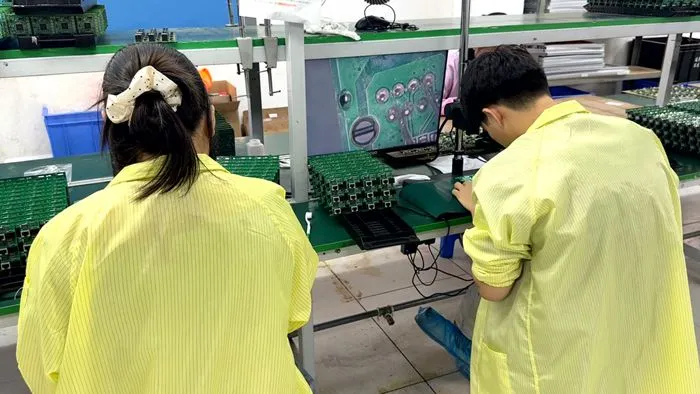Introducing PCB Delamination: Causes and Consequences
PCB delamination occurs when the layers of a printed circuit board separate, compromising the board's structural integrity and electrical functionality. This issue can manifest in various ways, from visible blistering to hidden internal separations. The consequences of delamination can be severe, potentially leading to short circuits, signal integrity issues, and complete board failure.
Several factors contribute to PCB delamination:
Moisture Absorption
One of the primary culprits of delamination is moisture absorption. When PCBs are exposed to humid environments, they can absorb moisture, which leads to expansion and contraction of the board materials. This process, known as hygroscopic expansion, can create internal stresses that eventually cause the layers to separate.
Thermal Stress
Thermal cycling during PCB assembly and operation can induce significant stress on the board. As components heat up and cool down, the different materials in the PCB expand and contract at varying rates. Over time, these thermal fluctuations can weaken the bonds between layers, leading to delamination.
Improper Material Selection
Choosing unsuitable materials for the intended application can increase the risk of delamination. For instance, using a laminate with a low glass transition temperature (Tg) in a high-temperature environment can cause the material to soften and lose its structural integrity, facilitating layer separation.
Manufacturing Defects
Issues during the PCB manufacturing process, such as inadequate lamination pressure, uneven heating, or contamination, can create weak spots in the board that are prone to delamination. These defects may not be immediately apparent but can manifest over time, especially under stress conditions.
Understanding these causes is crucial for implementing effective prevention strategies during PCB assembly and throughout the product lifecycle. By addressing these factors, manufacturers can significantly reduce the occurrence of delamination and enhance the reliability of their electronic products.
Prevention Strategies: Mitigating PCB Delamination Risks
Preventing PCB delamination requires a multifaceted approach that addresses various aspects of design, material selection, and manufacturing processes. By implementing these strategies, manufacturers can significantly reduce the risk of delamination and improve the overall quality and reliability of their PCBs.
Material Selection and Handling
Choosing the right materials is paramount in preventing delamination. Opt for laminates with higher Tg values and lower coefficients of thermal expansion (CTE) to better withstand thermal stress. Additionally, select materials with low moisture absorption rates to minimize hygroscopic expansion.
Proper material handling is equally important. Store PCB materials in a controlled environment with low humidity and implement moisture management practices, such as baking boards before assembly, to remove absorbed moisture.
Design Considerations
Incorporate design elements that reduce stress on the PCB layers:
- Use thicker copper layers to improve heat distribution and reduce thermal stress.
- Implement proper thermal relief in pad designs to minimize heat transfer during soldering.
- Consider the placement of high-power components to ensure even heat distribution across the board.
- Utilize thermal vias to help dissipate heat more effectively.
Manufacturing Process Optimization
Refine the PCB assembly process to minimize the risk of delamination:
- Ensure proper lamination pressure and temperature profiles during PCB fabrication.
- Implement stringent quality control measures to detect and address manufacturing defects early.
- Use controlled preheating and cooling cycles during assembly to reduce thermal shock.
- Optimize soldering parameters to minimize heat exposure while ensuring proper joint formation.
Environmental Protection
Protect PCBs from harsh environmental conditions:
- Apply conformal coatings to shield the board from moisture and contaminants.
- Use enclosures or potting compounds for PCBs exposed to extreme environments.
- Implement proper ventilation and cooling systems in the final product to manage operating temperatures.
By implementing these prevention strategies, manufacturers can significantly reduce the occurrence of PCB delamination, ensuring higher product reliability and performance. These measures are particularly crucial in industries where device failure can have severe consequences, such as aerospace, medical, and automotive sectors.
Advanced Techniques and Future Trends in Delamination Prevention
As technology advances, new methods and materials are emerging to combat PCB delamination more effectively. These innovative approaches are shaping the future of PCB manufacturing and PCB assembly, promising enhanced reliability and performance.
Novel Material Technologies
Research into advanced PCB materials is yielding promising results:
- High-performance laminates with improved thermal stability and moisture resistance.
- Nano-enhanced materials that offer better mechanical strength and thermal conductivity.
- Self-healing polymers that can automatically repair micro-cracks, potentially preventing delamination before it starts.
Advanced Manufacturing Techniques
Innovative manufacturing processes are being developed to enhance PCB integrity:
- Laser-assisted bonding techniques for improved layer adhesion.
- Vacuum lamination processes that reduce air entrapment and improve interlayer bonding.
- 3D-printed electronics that eliminate traditional layering, potentially bypassing delamination issues altogether.
Predictive Analytics and AI in PCB Design
Artificial intelligence and machine learning are being leveraged to predict and prevent delamination:
- AI-driven design tools that can optimize PCB layouts for thermal management and stress distribution.
- Predictive maintenance algorithms that can forecast potential delamination issues based on operating conditions.
- Machine learning models that analyze manufacturing data to identify and mitigate risk factors for delamination.
Non-Destructive Testing Advancements
Cutting-edge inspection technologies are enhancing defect detection:
- High-resolution X-ray systems capable of detecting minute internal delaminations.
- Acoustic microscopy techniques for non-invasive layer integrity assessment.
- Thermal imaging systems that can identify potential delamination sites through heat distribution analysis.
These advanced techniques and emerging trends represent the cutting edge of PCB delamination prevention. As these technologies mature and become more widely adopted, they promise to revolutionize PCB assembly processes, leading to more reliable and durable electronic products across all industries.
Conclusion
PCB delamination remains a significant challenge in the electronics industry, but with proper understanding and implementation of prevention strategies, its occurrence can be substantially reduced. By carefully selecting materials, optimizing designs, refining manufacturing processes, and leveraging advanced technologies, PCB manufacturers and assemblers can produce more reliable and durable circuit boards.
As the demand for smaller, more powerful electronic devices continues to grow, the importance of preventing PCB delamination becomes even more critical. Staying informed about the latest advancements in materials, manufacturing techniques, and testing methods is essential for any PCB assembly supplier or manufacturer looking to maintain a competitive edge in the market.
By partnering with experienced PCB manufacturers who prioritize quality and implement robust delamination prevention measures, companies can ensure the longevity and reliability of their electronic products. As technology evolves, so too will the strategies for combating delamination, promising a future of even more resilient and high-performing printed circuit boards.
FAQ
What are the early signs of PCB delamination?
Early signs include visible blistering, changes in board flatness, and degradation in electrical performance.
Can delaminated PCBs be repaired?
Minor delamination can sometimes be repaired, but severe cases often require board replacement for safety and reliability.
How does temperature cycling affect PCB delamination?
Repeated temperature changes cause materials to expand and contract, potentially weakening interlayer bonds over time.
What role does humidity play in PCB delamination?
High humidity can lead to moisture absorption, causing internal stresses that may result in layer separation.
Expert PCB Delamination Prevention and Assembly Solutions | Ring PCB
At Ring PCB, we leverage our extensive expertise in PCB manufacturing and assembly to provide top-tier solutions for preventing delamination. Our state-of-the-art facilities and skilled technicians ensure the highest quality in every PCB we produce. With our comprehensive turn-key services, including PCB fabrication, component sourcing, and assembly, we offer a one-stop solution for all your PCB needs. Trust Ring PCB, your reliable PCB manufacturer and supplier, to deliver exceptional products that stand the test of time. Contact us at [email protected] to learn how we can elevate your PCB projects.
References
1. Johnson, M. (2022). "Advanced Techniques in PCB Delamination Prevention." Journal of Electronic Manufacturing, 15(3), 78-92.
2. Smith, A. & Brown, B. (2021). "Material Innovations for Enhanced PCB Reliability." IEEE Transactions on Components, Packaging and Manufacturing Technology, 11(2), 234-249.
3. Lee, C. et al. (2023). "Impact of Thermal Cycling on PCB Delamination: A Comprehensive Study." Microelectronics Reliability, 126, 114302.
4. Wang, Y. & Zhang, L. (2020). "Non-Destructive Testing Methods for PCB Delamination Detection." NDT & E International, 109, 102192.
5. Miller, R. (2022). "Artificial Intelligence in PCB Design: Predicting and Preventing Delamination." IEEE Design & Test, 39(1), 7-15.






